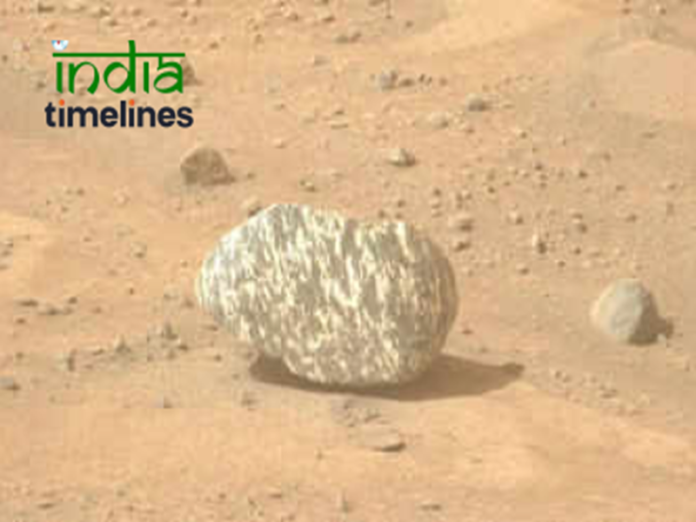
NASA’s Perseverance rover, which has been exploring Mars since 2021, has made yet another remarkable discovery—a unique ‘zebra’ rock. This rock, with its distinctive striped patterns, is captivating scientists and enthusiasts alike. But what does this unusual find mean for Martian exploration and the ongoing search for clues about Mars’ geological and environmental history?
In this article, we’ll dive into what this discovery could signify and how it may impact our understanding of Mars and its potential for past life.
What is the ‘Zebra’ Rock?
The term ‘zebra’ rock is inspired by the visually striking striped appearance of the stone. The alternating light and dark bands resemble the black and white stripes of a zebra. Such formations are rarely seen, even on Earth, and their presence on Mars is puzzling scientists.
Possible Causes of the Zebra-Like Pattern
The formation of these stripes could be due to several factors:
- Layered Sedimentation: One theory is that the stripes were formed over time through sedimentary processes. On Earth, layered sedimentary rocks are typically formed by the accumulation of different materials in distinct layers, which is also possible on Mars.
- Volcanic Activity: Another possibility is that the stripes were caused by volcanic activity, with different types of lava or volcanic ash creating the distinct bands.
- Water Interaction: There is also speculation that the zebra-like patterns could be a result of water flow on Mars in the distant past. Water might have deposited minerals in layers, leading to the striped appearance.
Why is This Discovery Important?
The discovery of the zebra rock is more than just a visual oddity. It could provide important clues about the history of Mars’ surface, especially in relation to water activity and geological processes.
- Evidence of Water Activity
One of the biggest questions about Mars is whether it once had liquid water on its surface. The discovery of layered rocks, especially those with patterns like the zebra rock, could provide further evidence that Mars had water in its past. If water did play a role in shaping these rocks, it increases the likelihood that Mars may have been habitable at some point in its history.
- Geological Insights
Understanding the composition of the zebra rock could give scientists a better idea of the geological history of Mars. If the rock is found to have been shaped by volcanic or sedimentary processes, it could reveal more about how Mars’ surface evolved over billions of years.
- Potential for Life
While finding life on Mars remains one of NASA’s primary goals, every new discovery provides a piece of the puzzle. If the zebra rock was influenced by water, it could offer insights into the type of environments where microbial life might have once existed. Studying rocks like this helps scientists determine where to search for signs of ancient life on Mars.
How Was the Zebra Rock Discovered?
NASA’s Perseverance rover has been exploring the Jezero Crater, a site believed to have once housed a lake. It’s equipped with advanced tools designed to analyze the surface of Mars, including a camera system called Mastcam-Z, which captured detailed images of the zebra rock.
These high-resolution images have allowed scientists on Earth to study the rock’s surface and make initial hypotheses about its origin. The rover is also capable of using its SHERLOC instrument (Scanning Habitable Environments with Raman & Luminescence for Organics & Chemicals) to examine the rock’s chemical composition.
What Could the Zebra Rock Reveal About Mars’ Past?
As scientists analyze the zebra rock, there are several key questions they hope to answer:
- What minerals are present? By determining the rock’s composition, scientists can get a clearer picture of the environmental conditions that shaped it.
- How old is the rock? Understanding the age of the rock could help place it within Mars’ geological timeline, providing insights into the planet’s past.
- Was water involved in its formation? If water played a role in creating the zebra-like patterns, it could provide more evidence for liquid water on Mars in the distant past.
What’s Next for Martian Exploration?
The discovery of the zebra rock is just one of many exciting finds from NASA’s Mars missions. As the Perseverance rover continues to explore the Jezero Crater, it’s expected to uncover more geological treasures that will enhance our understanding of the Red Planet.
- Sample Collection
One of the most anticipated aspects of the Perseverance mission is the collection of rock samples. NASA plans to return these samples to Earth in the next decade, which will allow for more in-depth analysis in terrestrial labs. If samples from the zebra rock are included, scientists will be able to perform more detailed tests to uncover its origins.
- Future Missions
NASA’s ongoing Mars exploration includes plans for more advanced missions, including sending astronauts to the Martian surface. Each discovery, including the zebra rock, helps inform future missions and could influence landing sites, scientific priorities, and the search for life.
Conclusion: A Striped Puzzle for Scientists
The discovery of the zebra rock on Mars adds another layer of intrigue to our exploration of the Red Planet. While scientists have several theories about how this unusual formation came to be, the full story remains to be uncovered. Whether it’s evidence of water, volcanic activity, or something else entirely, the zebra rock is a valuable clue in our ongoing quest to understand Mars’ geological history and its potential to support life.
As the Perseverance rover continues its journey, we can expect even more groundbreaking discoveries that bring us closer to answering the age-old question: was there ever life on Mars?
FAQs
- What is the zebra rock on Mars? The zebra rock is a newly discovered rock formation with distinctive black and white stripes, similar to the pattern of a zebra, found by NASA’s Perseverance rover on Mars.
- How was the zebra rock formed? Scientists believe the stripes could have formed through sedimentary processes, volcanic activity, or interactions with water in Mars’ past.
- Why is the zebra rock important? The rock may provide important clues about Mars’ geological history and the role of water on the planet, which could inform the search for ancient life.
- How did NASA discover the zebra rock? NASA’s Perseverance rover captured high-resolution images of the zebra rock using its advanced camera systems while exploring the Jezero Crater.
5. What’s next for the zebra rock?
NASA scientists will continue to analyze the zebra rock’s composition and may include it in samples to be returned to Earth for further study in the future.
































Wow, amazing blog layout! How long have you been blogging for? you made blogging look easy. The overall look of your web site is magnificent, as well as the content!
http://smmib.ru/ – современный подход к созданию функционального интерьера.
A signature is an essential part of everyday life, from contracts to personal branding. Whether you need a digital version or a handcrafted one, we help you sign with confidence and style. Our expertly designed signatures are tailored to suit your needs, ensuring clarity, uniqueness, and authenticity. Upgrade your signing experience with a signature that truly represents you!
Some times its a pain in the ass to read what website owners wrote but this site is very user friendly! .
I’m not that much of a online reader to be honest but your blogs really nice, keep it up! I’ll go ahead and bookmark your site to come back later. All the best